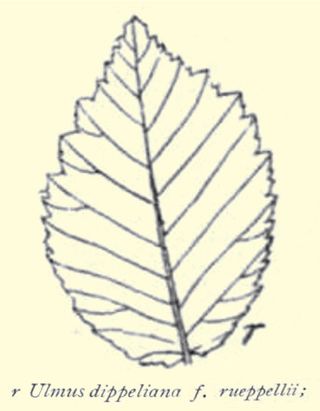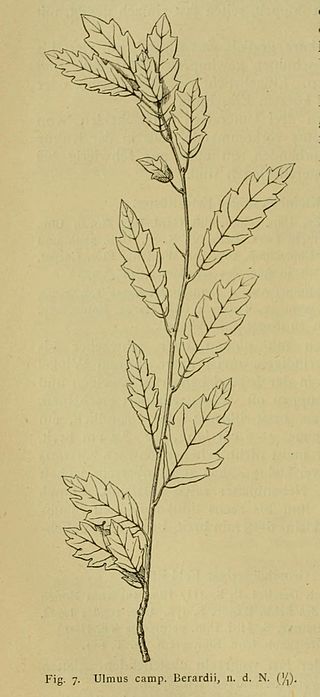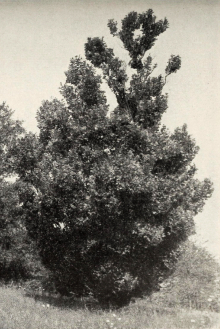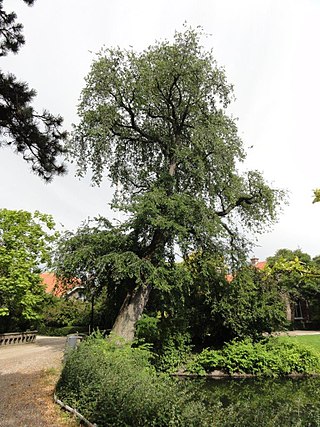The Field Elm cultivar Ulmus minor 'Viminalis Marginata', a variegated form of Ulmus minor 'Viminalis', was first listed as Ulmus campestris var. viminalis marginataHort. by Kirchner in 1864. Both Van Houtte and Späth marketed an U. campestris viminalis marginata in the late 19th century.

The elm cultivar Ulmus 'Crispa' [:'curled', the leaf margin], sometimes known as the Fernleaf Elm, arose before 1800 and was first listed by Willdenow as U. crispa (1809). Audibert listed an U. campestrisLinn. 'Crispa', orme à feuilles crépues [:'frizzy-leaved elm'], in 1817, and an Ulmus urticaefolia [:'nettle-leaved elm'] in 1832; the latter is usually taken to be a synonym. Loudon considered the tree a variety of U. montana (1838). In the 19th century, Ulmus × hollandica cultivars, as well as those of Wych Elm, were often grouped under Ulmus montana. Elwes and Henry (1913) listed 'Crispa' as a form of wych elm, but made no mention of the non-wych samara.

The Field Elm cultivar Ulmus minor 'Propendens', described by Schneider in 1904 as U. glabra (:minor) var. suberosa propendens, Weeping Cork-barked elm, was said by Krüssmann (1976) to be synonymous with the U. suberosa pendula listed by Lavallée without description in 1877. Earlier still, Loudon's Arboretum et Fruticetum Britannicum had included an illustration of a pendulous "cork-barked field elm", U. campestris suberosa. An U. campestris suberosa pendula was in nurseries by the 1870s.
The elm cultivar Ulmus 'Monstrosa' [: "monstrous", "strange"], a shrub-elm with fasciated branching, is believed to have originated in France, where it was first listed by Lavallée in Arboretum Segrezianum (1877) as a form of Field Elm, Ulmus campestris var. monstrosa, but without description. Though its long slender 2 cm petiole is not a feature of wych elm U. glabraHuds., and is even less likely in a shrub form of this species, the wych-cultivar error arose early, perhaps because the Späth nursery of Berlin, using Ulmus montana both for some Ulmus × hollandica cultivars and for wych varieties, listed it c.1890 as Ulmus montana monstrosa. Hartwig in Illustrirtes Gehölzbuch (1892) followed with Ulmus scabra monstrosa, an error repeated by Krüssman (1962) and by Green (1964), with their U. glabraHuds. 'Monstrosa'.

Ulmus minor 'Rueppellii' is a Field Elm cultivar said to have been introduced to Europe from Tashkent by the Späth nursery, Berlin. Noted in 1881 as a 'new elm', it was listed in Späth Catalogue 73, p. 124, 1888–89, and in subsequent catalogues, as Ulmus campestris Rueppelli, and later by Krüssmann as a cultivar.

The elm cultivar Ulmus 'Berardii', Berard's Elm, was raised in 1865, as Ulmus Berardi, from seeds collected from large specimens of "common elm" growing on the ramparts at Metz, by an employee of the Simon-Louis nursery named Bérard. Carrière (1887), the Späth nursery of Berlin and the Van Houtte nursery of Gentbrugge regarded it as form of a Field Elm, listing it as U. campestris Berardii, the name used by Henry. Cheal's nursery of Crawley distributed it as Ulmus nitens [:Ulmus minor] 'Berardii'. Smith's of Worcester preferred the original, non-specific name, Ulmus 'Berardii'.

The elm cultivar Ulmus 'Koopmannii' was cloned from a specimen raised from seed sent from Margilan, Turkestan by Koopmann to the Botanischer Garten Berlin c. 1880. Noted in 1881 as a 'new elm', it was later listed by the Späth nursery, catalogue no. 62, p. 6. 101, 1885, as Ulmus Koopmannii, and later by Krüssmann in 1962 as a cultivar of U. minor. Margilan is beyond the main range of Ulmus minor. Augustine Henry, who saw the specimens in Berlin and Kew, believed Koopmann's Elm to be a form of Ulmus pumila, a view not shared by Rehder of the Arbold Arboretum. Ascherson & Graebner said the tree produced 'very numerous root shoots', which suggests it may be a cultivar of U. minor. Until DNA analysis can confirm its origin, the cultivar is now treated as Ulmus 'Koopmannii'.
The Elm cultivar Ulmus 'Tiliaefolia' was first mentioned by Host in Flora Austriaca (1827), as Ulmus tiliaefolia [:linden-leaved]. The Späth nursery of Berlin distributed a 'Tiliaefolia' from the late 19th century to the 1930s as neither an U. montana hybrid nor a field elm cultivar, but simply as Ulmus tiliaefolia, suggesting uncertainty about its status. Herbarium specimens appear to show two clones, one smaller-leaved and classified as a field elm cultivar, the other larger-leaved.
The Field Elm cultivar Ulmus minor 'Concavaefolia' was briefly described by Loudon in Arboretum et Fruticetum Britannicum (1838), as Ulmus campestris var. concavaefolia. A fuller description followed in Petzold and Kirchner 's Arboretum Muscaviense (1864). Henry noted that Loudon's "insufficiently described" U. campestris var. concavaefolia seemed to be identical with the field elm cultivar 'Webbiana', a view repeated by Krüssmann.
The Field Elm cultivar Ulmus minor 'Cucullata', the Hooded elm, was listed by Loddiges of Hackney, London, in their catalogue of 1823 as Ulmus campestris cucullata, and later by Loudon in Arboretum et Fruticetum Britannicum (1838), as U. campestris var. cucullata.

Ulmus × hollandica 'Klemmer', or Flanders Elm, is probably one of a number of hybrids arising from the crossing of Wych Elm with a variety of Field Elm, making it a variety of Ulmus × hollandica. Originating in the Bruges area, it was described by Gillekens in 1891 as l'orme champêtre des Flandres in a paper which noted its local name, klemmer, and its rapid growth in an 1878–91 trial. Kew, Henry (1913), and Krüssmann (1976) listed it as an Ulmus × hollandica cultivar, though Henry noted its "similarity in some respects" to field elm Ulmus minor, while Green went as far as to regard it as "possibly U. carpinifolia" (:minor).

The Field Elm cultivar Ulmus minor 'Umbraculifera Gracilis' was obtained as a sport of 'Umbraculifera' by the Späth nursery of Berlin c.1897. It was marketed by the Späth nursery in the early 20th century, and by the Hesse Nursery of Weener, Germany, in the 1930s.
The Field Elm cultivar Ulmus minor 'Microphylla Pendula', the Weeping small-leaved elm, was first listed by the Travemünde nursery, Lübeck, and described by Kirchner in Petzold & Kirchner's Arboretum Muscaviense (1864), as Ulmus microphylla pendulaHort.. By the 1870s it was being marketed in nurseries in Europe and America as Ulmus campestris var. microphylla pendula.
The elm cultivar Ulmus 'Lombartsii' is considered "possibly Ulmus × hollandica or Ulmus carpinifolia " by Green (1964). The tree was raised by Lombarts Nurseries at Zundert, Netherlands, circa 1910.

The Field Elm cultivar Ulmus minor 'Pendula' was said to have been raised in Belgium in 1863. It was listed as Ulmus sativa pendula by C. de Vos in 1887, and by Boom in 1959 as a cultivar.

The elm cultivar Ulmus 'Scampstoniensis', the Scampston Elm or Scampston Weeping Elm, is said to have come from Scampston Hall, Yorkshire, England, before 1810. Loudon opined that a tree of the same name at the Royal Horticultural Society's Garden in 1834, 18 feet (5.5 m) high at 8 years old "differed little from the species". Henry described the tree, from a specimen growing in Victoria Park, Bath, as "a weeping form of U. nitens" [:Ulmus minor ]; however Green considered it "probably a form of Ulmus × hollandica". Writing in 1831, Loudon said that the tree was supposed to have originated in America. U. minor is not, however, an American species, so if the tree was brought from America, it must originally have been taken there from Europe. There was an 'American Plantation' at Scampston, which may be related to this supposition. A number of old specimens of 'Scampstoniensis' in this plantation were blown down in a great gale of October 1881; younger specimens were still present at Scampston in 1911.
The Field Elm cultivar Ulmus minor 'Rugosa' was distributed by the Späth nursery, Berlin, in the 1890s and early 1900s as U. campestris rugosaKirchner. Kirchner's tree, like Späth's a level-branched suberose field elm, was received from Belgium in 1864 as Ulmus rugosa pendula. Kirchner stressed that it was different from Loudon's Ulmus montana var. rugosa, being "more likely to belong to U. campestris or its subspecies, the Cork-elm".
The Field Elm cultivar Ulmus minor 'Viminalis Betulaefolia' (:'birch-leaved') is an elm tree of uncertain origin. An U. betulaefolia was listed by Loddiges of Hackney, London, in the catalogue of 1836, an U. campestris var. betulaefolia by Loudon in Arboretum et Fruticetum Britannicum (1838), and an U. betulifoliaBooth by the Lawson nursery of Edinburgh. Henry described an U. campestris var. betulaefolia at Kew in 1913, obtained from Fulham nurseryman Osborne in 1879, as "scarcely different from var. viminalis ". Melville considered the tree so named at Kew a form of his U. × viminalis, while Bean (1988), describing U. 'Betulaefolia', likewise placed it under U. 'Viminalis' as an apparently allied tree. Loudon and Browne had noted that some forms of 'Viminalis' can be mistaken for a variety of birch. An U. campestris betulaefolia was distributed by Hesse's Nurseries, Weener, Germany, in the 1930s.

The Field Elm cultivar Ulmus minor 'Monumentalis', the tomb elm (Grabmal-Rüster), was raised as a sucker of U. suberosa by Sebastian Rinz, the city gardener of Frankfurt, before 1855 and listed by the Jacob-Makoy nursery of Liège in their 1861 catalogue as Ulmus monumentalisRinz, "a new variety". Kirchner (1864) described it, confirming that it had only recently been propagated by Rinz and established in the nursery. It was distributed from the 1880s by the Baudriller nursery, Angers, and by the Späth nursery, Berlin, as U. campestris monumentalisRinz., appearing separately in their catalogues from U. minor 'Sarniensis', the Guernsey or Wheatley Elm, with which, according to Henry, it was confused on the continent. Krüssmann, for example, gives 'Monumentalis' as a synonym of 'Sarniensis'. 'Sarniensis' is known as monumentaaliep [:monumental elm] in The Netherlands. Springer noted that the Dutch monumentaaliep was "not the actual monumentaaliep but U. glabraMill.var. Wheatleyi Sim. Louis", and that it "should be renamed U. glabraMill. var. monumentalisHort.(non Rinz)". In England, Smith's of Worcester listed Ulmus monumentalis separately from Ulmus 'Wheatley' in the 1880s.

The Wych Elm cultivar Ulmus glabra 'Concavaefolia', a form with up-curling leaves, was listed in Beissner's Handbuch der Laubholz-Benennung (1903) as Ulmus montana cucullataHort. [:'hooded', the leaf], a synonym of the Ulmus scabraMill. [:glabraHuds.] var. concavaefolia of herbarium specimens. An Ulmus campestris cucullata, of uncertain species, had appeared in Loddiges' 1823 list, but Loudon's brief description (1838) of concave- and hooded-leaved elms was insufficient for later botanists to distinguish them. The earliest unambiguous description appears to be that of Petzold and Kirchner in Arboretum Muscaviense (1864).











